Following the Public Meeting on the removal of A167 lights Great Aycliffe Residents’ Association were only allowed to ask 3 questions on the subject at the Council Meeting. Accordingly it was agreed to ask all the queries residents had under the Freedom of Information Act. The following is the response received:
On this occasion we have handled your request under the Environmental Information Regulations, 2004 (EIR). This is because your enquiry relates to measures which affect the environment. Freedom of Information requests concern non environmental information.
You requested 1:
Is the Council satisfied the policy change was understood and communicated properly to the general public?
Our response: Under the EIR this question, as phrased, is not asking for recorded information. As phrased it is asking for opinion and as such falls outside the scope of the Regulations.
To note: We can advise that the Street Lighting Policy which facilitates the removals was approved by Cabinet on 20 November 2013 following extensive public consultation including all Town and Parish Councils within County Durham. The public consultations included public meetings and publicity to enable the public and Town and Parish Councils to put forward their views.
Once street lights are identified for potential removal we consult with County Councillors, Town and Parish Councils on the Road Safety Risk assessment to seek local knowledge which may be used to help inform the risk assessment.
You requested 2:
1. How many members of the public were in fact consulted?
Our response: Under Regulation 12(4)(a) of the EIR we do not hold a record of numbers consulted. To note: Please see our note section above in response to question 1.
You requested 3:
When Residents’ Associations call for clarification do we not deserve attention with the officer and Cabinet Councillor, responsible for the topic, attending the meeting?
Our response: Please see our response to question 1.
You requested 4:
On investigation and having sight of the plans we seek clarification on the County Council’s specific areas which they term “rural”. Where they state lighting can be safely removed?
Our response: We can advise that all proposals for street lighting removals conform to the Council’s Street Lighting Policy. The provision of street lighting is based on Environmental Zones as follows:
Environmental Zone E1 Comprises of National Parks, Areas
of Outstanding Natural Beauty, Sites of Specific Scientific Importance and other Dark Areas. Environmental Zone E2 Area of low District Brightness (Rural Locations outside Zone E1) Environmental Zone E3 & E4 Areas of Medium District Brightness (Urban Locations) and areas of High District Brightness (Urban Centres with high night-time usage) The areas where it is proposed to remove the street lighting are within Zone E2. The immediate environment of the highway within Zone E2 comprises areas that are of low brightness, predominately agricultural/rural/open land with sporadic or few dwellings.
You requested 5:
As the A167 is a main arterial route through the County can the Council please define rural areas along the A167?
Our response: Please see our response to question 4 for definition of rural areas.
You requested 6:
Is this where there is no footfall?
Our response: Please see our response to question 1. To note: The decision to remove street lighting is not based on footfall.
The road safety risk assessment process includes visiting the site and walking the route allowing for a detailed assessment of the character of the road, its environment, the condition of the existing traffic signs and road markings. The risk assessment identifies any potential hazards to highway users and considers if these can be mitigated.
You requested 7:
Has the County Council discussed issues of Health & Safety, Road Accidents, dangers to cyclists and walkers plus potential increase in crime?
Our response: The Council has commissioned independent road safety auditors to carry out robust and detailed road safety risk assessments at each site where street lighting has been proposed for removal in accordance with the above policy. As stated above, the risk assessment includes a detailed analysis of all Personal Injury Accidents (PIA’s) and it also includes visiting the site and walking the route to identify any potential hazards to highway users. Anecdotal evidence suggests that crime has not increased as a result of street lighting being removed. There is generally little or no opportunity for crime to be committed in the rural locations in between settlements where we are removing street lights. The latest research commissioned by the Department for Transport confirms that street lighting has an important role in reducing the fear of crime but that there is no evidence that it reduces actual crime.
You requested 8:
Why not turn off every other light?
Our response: Please see our response to question 1. To note: This is not a viable or safe option as to remove alternate street
lighting would lead to short lengths of light going into short lengths of darkness. This has a detrimental impact on the human eye’s adjustment to the lighting level, known as ‘relative eye response’ which can be dangerous for road users. It is far better to have longer lengths of lit and unlit road to enable the human eyes to adjust accordingly.
You requested 9:
Why not use alternative modern and much cheaper lighting to get the same monetary savings?
Our response: Under the Street Lighting Energy Reduction Project we are retrofitting over 41,000 street lights with more energy efficient LEDs. To note: With limited resources we cannot maintain street lighting including LEDs and/or columns that are not specifically required under the Street Lighting Policy.
You requested 10:
Why remove lampposts altogether?
Our response: Please see our response to question 9.
You requested 11:
If the A1M is closed at our junctions the A167 becomes the alternative route has this been considered?
Our response: It is acknowledged that the A167 may be used as an alternative route for the A1(M) and that the A167 is one of the main north/south transport routes through the county.
To note 1: We can confirm that under our Street Lighting Policy, which is aligned with British Standards, we are committed to retaining street lights in residential areas, roundabouts, major junctions and where there are proven road safety and crime issues. To note 2: Under British Standards it is not necessary to light main roads in rural areas between settlements (areas of low district brightness). Consequently, these main roads are generally not lit in County Durham or the rest of the United Kingdom. Similarly, many sections of the A1(M) are not lit.
You requested 12:
The A167 is a main arterial route through the County carrying goods services and workers between settlements and beyond. Would you agree that any disruption of traffic flow could have severe financial results on the local economy?
Our response: Please see our response to question 1.
You requested 13:
If statistics later show this to be highly dangerous and the wrong decision will the Council re-instate lampposts and is there a budget to cover this expense?
Our response: Under section 12(4)(a) of the EIR the council does not hold this recorded information. Accidents can and do occur at any time on any part of the highway network regardless of the provision of street lighting. Serious accidents are investigated in conjunction with Durham Constabulary to identify the cause and consider any mitigation measures. Fatal accidents are investigated by the Coroner supported by Durham Constabulary. Accidents may occur in the future where we have removed street lighting just like any other part of the highway network. However, we do not consider that any potential accidents will be caused by the removal of street lighting. As highlighted above we are only removing street lights that are not required by British Standards where it is safe to do so following a robust risk assessment by independent road safety auditors.
You requested 14:
Is it not wrong when the “spotlight” is on Aycliffe Business Park as the biggest in our County and potentially the biggest industrial area in the north east to turn lights off to its approach?
Our response: Please see our response to question 1.
To note 1: We can confirm that no street lights will be removed at the following locations: 2. St Cuthbert’s Way; 3. Heighington Lane; 4. St Andrew’s Way roundabout. To note 2: We can confirm that Under our Street Lighting Policy we are
committed to retaining street lights in residential areas, roundabouts, major junctions and where there are proven road safety and crime issues.
You requested 15:
What does this say to visitors and possible investors about Aycliffe Business Park?
Our response: Please see our response to question 1.
You requested 16:
Have risk assessments been carried out by the emergency services?
Our response: We can advise that a robust and detailed road safety risk assessment has been undertaken at each site where street lighting has been proposed for removal, in line with our Street Lighting Policy. The risk assessment process includes visiting the site and walking the route allowing for a detailed assessment of the character of the road, its environment, the condition of the existing traffic signs and road markings ensuring any inherent potential hazards to highway users are identified and actions taken to either remove the hazard or introduce mitigation measures. Therefore, there will be no hazards that would impede the emergency services.
Review Procedure
I hope that this information is of assistance. However, if you are dissatisfied with the handling of your request, please contact: The Information Management Team Tel:03000268034 Email: foi@durham.gov.uk After you have exhausted our internal appeals procedure, you also have a right of appeal to the Information Commissioner at: Telephone: 01625 545 745 Email: casework@ico.org.uk
Julie Hodgson
Freedom of Information Officer










